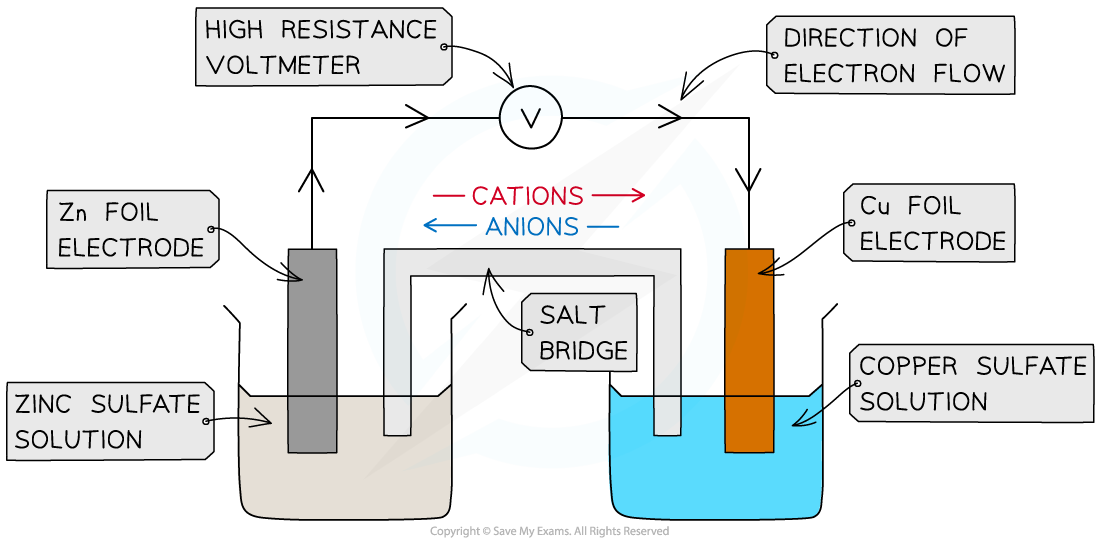Electrochemical Cells
- We have seen previously that redox reactions involve simultaneous oxidation and reduction as electrons flow from the reducing agent to the oxidizing agent
- Which way electrons flow depends on the reactivity of the species involved
- Redox chemistry has very important applications in electrochemical cells, which come in two types:
- Voltaic cells
- Electrolytic cells
Voltaic cells
- A voltaic cell generates a potential difference known as an electromotive force or EMF
- The EMF is also called the cell potential and given the symbol E
- The absolute value of a cell potential cannot be determined only the difference between one cell and another
- This is analogous to arm-wrestling: you cannot determine the strength of an arm-wrestler unless you compare her to the other competitors
- Voltaic (or Galvanic) cells generate electricity from spontaneous redox reactions
- For example:
Zn (s) + CuSO4 (aq)→ Cu (s) + ZnSO4 (aq)
- Instead of electrons being transferred directly from the zinc to the copper ions, a cell is built which separates the two redox processes
- Each part of the cell is called a half cell
- If a rod of metal is dipped into a solution of its own ions, an equilibrium is set up
- For example:
Zn (s) ⇌ Zn2+ (aq) + 2e–

When a metal is dipped into a solution contains its ions an equilibrium is established between the metal and it ions
- This is a half cell and the strip of metal is an electrode
- The position of the equilibrium determines the potential difference between the metal strip and the solution of metal
- The Zn atoms on the rod can deposit two electrons on the rod and move into solution as Zn2+ ions:
Zn(s) ⇌ Zn2+(aq) + 2e–
- This process would result in an accumulation of negative charge on the zinc rod
- Alternatively, the Zn2+ ions in solution could accept two electrons from the rod and move onto the rod to become Zn atoms:
Zn2+(aq) + 2e– ⇌ Zn(s)
- This process would result in an accumulation of positive charge on the zinc rod
- In both cases, a potential difference is set up between the rod and the solution
- This is known as an electrode potential
- A similar electrode potential is set up if a copper rod is immersed in a solution containing copper ions (eg CuSO4), due to the following processes:
Cu2+(aq) + 2e– ⇌ Cu(s) – reduction (rod becomes positive)
Cu(s) ⇌ Cu2+(aq) + 2e– – oxidation (rod becomes negative)
- Note that a chemical reaction is not taking place – there is simply a potential difference between the rod and the solution
Creating an EMF
- If two different electrodes are connected, the potential difference between the two electrodes will cause a current to flow between them. Thus an electromotive force (EMF) is established and the system can generate electrical energy
- A typical electrochemical cell can be made by combining a zinc electrode in a solution of zinc sulfate with a copper electrode in a solution of copper sulfate

The zinc-copper voltaic cell (also known as the Daniell Cell)
- The circuit must be completed by allowing ions to flow from one solution to the other
- This is achieved by means of a salt bridge
- This is often a piece of filter paper saturated with a solution of an inert electrolyte such as KNO3(aq)
- The EMF can be measured using a voltmeter
- Voltmeters have a high resistance so that they do not divert much current from the main circuit
- The two half cells are said to be in series as the same current is flowing through both cells
- The combination of two electrodes in this way is known as a voltaic cell, and can be used to generate electricity
Cell Potential Calculations
- Voltmeters measure potential on the right-hand side of the cell and subtract it from the potential on the left-hand side of the cell
EMF= Eright - Eleft
- Sometimes this can be hard to remember, but it helps if you remember the phrase 'knives & forks'

You hold your knife in your right hand and your fork in your left hand. EMF is right minus left
- If the standard hydrogen electrode is placed on the left-hand side of the voltmeter, then by convention Eleft will be zero and the EMF of the cell will be the electrode potential of the right-hand electrode
- For example, if the standard zinc electrode is connected to the standard hydrogen electrode and the standard hydrogen electrode is placed on the left, the voltmeter measures -0.76V.
Zn2+(aq) + 2e- ⇌ Zn(s)
- The Zn2+(aq) + 2e- ⇌ Zn(s) half-cell thus has an electrode potential of -0.76V
- If the Cu2+(aq) + 2e- ⇌ Cu(s) electrode is connected to the standard hydrogen electrode and the standard hydrogen electrode is placed on the left, the voltmeter reads +0.34V
- The Cu2+(aq) + 2e- ⇌ Cu(s) half-cell thus has an electrode potential of +0.34V.
Standard electrode potential
- The standard electrode potential of a half-reaction is the emf of a cell where the left-hand electrode is the standard hydrogen electrode and the right-hand electrode is the standard electrode in question
- The equation EMF = ERHS - ELHS can be applied to electrochemical cells in two ways:
- Calculating an unknown standard electrode potential
- Calculating a cell EMF
- To be a standard electrode potential the measurements must be made at standard conditions, namely:
- 1.0 mol dm-3 ions concentrations
- 100 kPa pressure
- 298 K
Calculating an unknown standard electrode potential
- If the RHS and LHS electrode are specified, and the EMF of the cell measured accordingly, then if the Eθ of one electrode is known then the other can be deduced.
- For example, if the standard copper electrode (+0.34 V) is placed on the left, and the standard silver electrode is placed on the right, the EMF of the cell is +0.46 V.
- Calculate the standard electrode potential at the silver electrode.
EMF = ERHS - ELHS
+0.46 = EθAg - (+0.34 V)
EθAg = 0.46 + 0.34 = +0.80 V
Calculating a cell EMF
- If both SEP's are known, the EMF of the cell formed can be calculated if the right-hand electrode and left-hand electrode are specified
- For example, if in a cell the RHS = silver electrode (+0.80V) and LHS is copper electrode (+0.34 V), then
EMF = ERHS - ELHS
EMF = +0.80 - 0.34 = +0.46 V
Conventional Representation of Cells
- As it is cumbersome and time-consuming to draw out every electrochemical cell in full, a system of notation is used which describes the cell in full, but does not require it to be drawn.
- An electrochemical cell can be represented in a shorthand way by a cell diagram (sometimes called cell representations or cell notations)

The conventional representation of voltaic cells
- By convention, the half cell with the greatest negative potential is written on the left of the salt bridge, so Eθcell = Eθright – Eθleft
- In this case, Eθcell = +0.34 – -0.76 = +1.10 V.
- The left cell is being oxidized while the right is being reduced
- If there is more than one species in solution, and the species are on different sides of the half-equation, the different species are separated by a comma
- This method of representing electrochemical cells is known as the conventional representation of a cell, and it is widely used
- If both species in a half reaction are aqueous then an inert platinum electrode is needed which is recorded on the outside of the half cell diagram
Some Examples
- For the iron(II) and iron(III) half cell reaction a platinum electrode is needed as an electron carrier
- The half equation is
Fe3+(aq) + e- ⇌ Fe2+(aq)
- So the cell convention as a left hand electrode would be
Pt 丨Fe2+(aq), Fe3+(aq)
- Notice the order must be Fe(II) then Fe(III) as the left side is an oxidation reaction, so Fe(II) is oxidised to Fe(III) by the loss of an electron
- The platinum electrode is separated by the phase boundary (vertical solid line), but the iron(II) and iron(III) are separated by a comma since they are in the same phase
- Non-metals will also require a platinum electrode
- If chlorine is used as an electrode the reduction reaction is
Cl2(g) + 2e- ⇌ 2Cl-(aq)
- The conventional representation of the half reaction would be
Cl2 (g), 2Cl- (aq) | Pt
- Notice that the half cell reaction is balanced; however, it would be also correct to write it as
Cl2 (g), Cl- (aq) | Pt
- This is because conventional cell diagrams are not quantitative- they are just representations of the materials and redox processes going on
- Most chemists tend to show them balanced anyway
- Combining these two half cells together gives
Pt | Fe2+(aq), Fe3+(aq) ∥ Cl2 (g), 2Cl- (aq) | Pt
- As you can see the overall cell diagram is not quantitative as the left side is a one electron transfer and the right side is a two electron transfer
